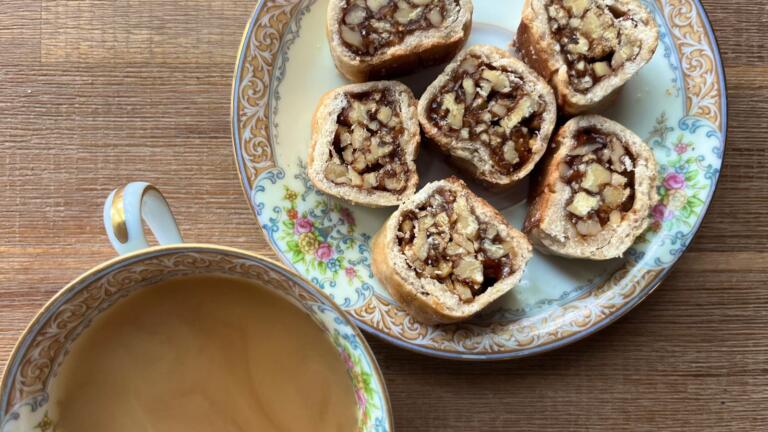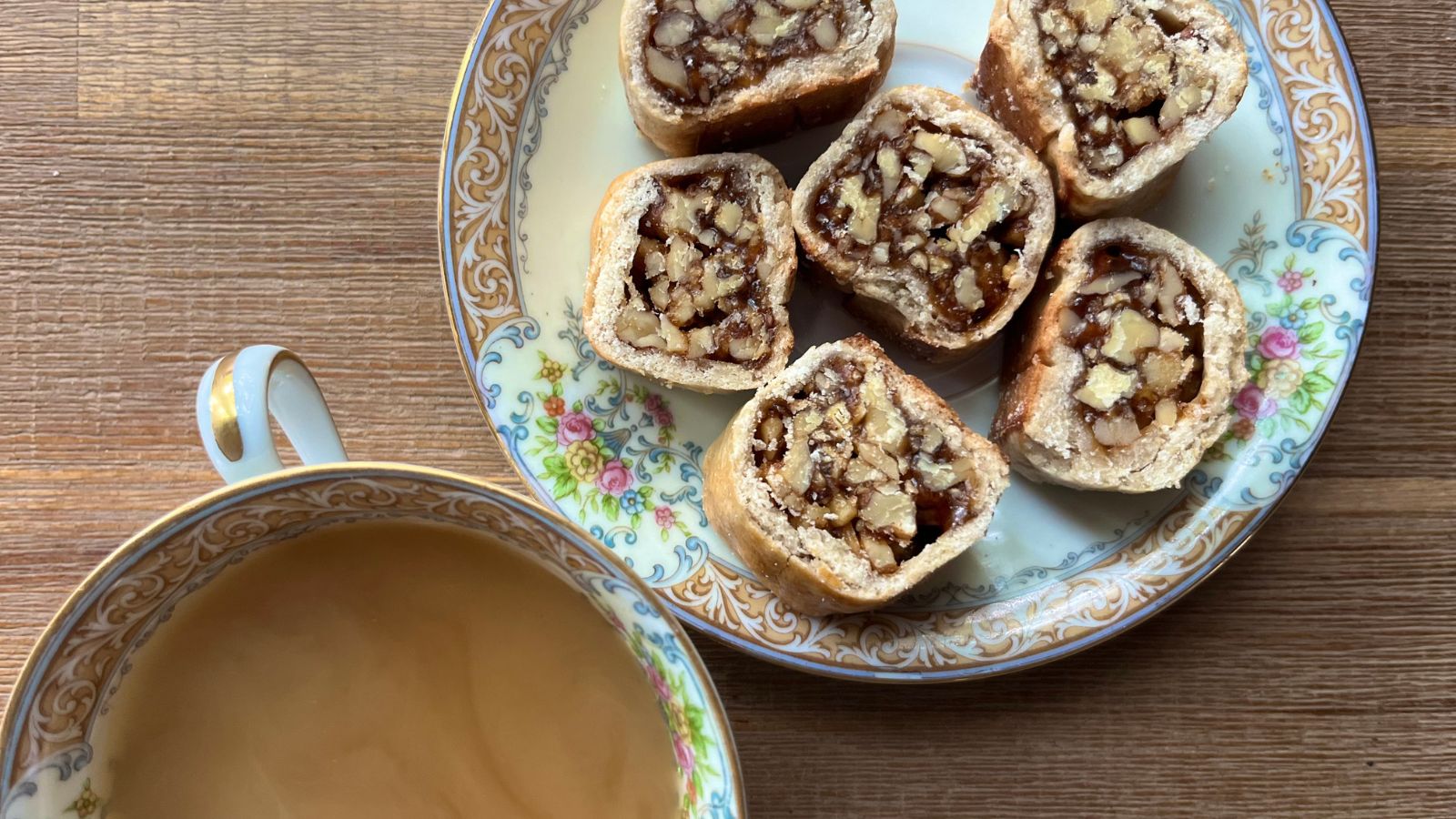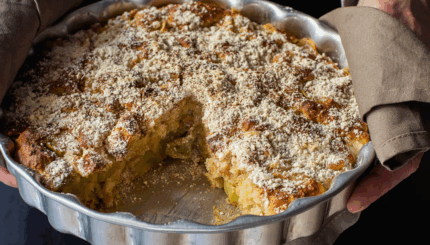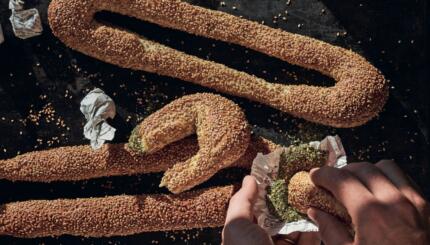When one thinks about eating dessert, the words “pain and suffering” rarely come to mind.
Notably, however, a handful of popular Jewish sweet foods specifically commemorate unhappy events in Jewish history.
The most widely-known example is hamantaschen – the tri-cornered pastry that represents the hat (or ear or pocket, depending on whom you ask) of Purim’s notorious villain and oppressor, Haman. Likewise, the Passover seder plate includes a scoop of haroset – a tasty amalgam of sweet and sticky ingredients that, when combined, resemble the brick mortar used by the enslaved Israelites in Egypt.
A third example of the “sad sweets” phenomenon includes sfratti – a honey and walnut cookie that hails from Italy, and specifically the town Pitigliano. From the 15th through 19th centuries, Pitigliano was home to a significant Jewish community, enough so that it earned the nickname “little Jerusalem.” And these sticky, chewy cookies, which texturally resemble sesame candies wrapped in dough, were often served for Rosh Hashanah.
The Nosher celebrates the traditions and recipes that have brought Jews together for centuries. Donate today to keep The Nosher's stories and recipes accessible to all.
The cookie’s name, sfratto (sfratti is plural), comes from the Italian word that means “eviction.” According to “The Classic Cuisine of the Italian Jews” by Edda Servi Machlin, “There was a time when the law that prevailed was the ‘law of the stick.’ When landlords could not collect from poor tenants, they would evict them with the persuasive aid of a stick. The same treatment was applied to the Jews when they were no longer wanted in a community.” Fittingly, sfratti are rolled into stick-shaped logs before being baked, and then sliced into smaller pieces for serving.
The Jewish fascination with depressing desserts in general, can be interpreted either as an attempt to dust a little sugar over bad memories – or to immortalize the centuries of oppression and scorn as if to say, “Even in the good times, we must remember the bad.” Consuming a dessert that represents a negative experience inherently implies that the Jewish people have not only survived through the era of hardships, but thrived enough to have a little dessert. In other words, sfratti – like hamantaschen or haroset – are a tasty embodiment of the celebratory phrase: “They tried to kill us, we survived, let’s eat!”
Notes:
- You can use a large, sharp knife and a cutting board to chop the walnuts, or pulse them in a food processor until finely chopped with a few slightly larger pieces.
- Store the cookies in an airtight container at room temperature for up to 3 days, in the fridge for 1 week, or in the freezer for 3 months.

Sfratti
Sfratti are rolled into stick-shaped logs before being baked, and then sliced into smaller pieces for serving.
- Total Time: 3 hours + 5 minutes
- Yield: Makes about 30 cookies
Ingredients
For the dough:
- 2 cups all-purpose flour
- ½ cup granulated sugar
- ¼ tsp kosher salt
- ¼ cup sunflower oil (or other neutral vegetable oil)
- ¼ cup dry white wine, plus more as needed
For the filling and assembly:
- ¾ cup honey
- ½ tsp ground cinnamon
- ⅛ tsp ground cloves
- ⅛ tsp freshly ground black pepper
- 2½ cups walnut halves, finely chopped
- zest of 1 medium lemon
- zest of 1 medium orange
- 1 large egg, beaten with 1 teaspoon water, for the egg wash
- confectioner’s sugar, for dusting
Instructions
- Make the dough: Whisk together the flour, granulated sugar and salt in a medium bowl. Make a well in the center of the flour mixture and add the oil and wine. Stir to bring the dough together, then knead with your hands (in the bowl or on a counter) until a smooth dough forms. If the dough is too dry to hold together when squeezed, add more wine, a little at a time until the desired consistency is reached.
- Gather the dough and divide it into 4 pieces. Wrap each well in parchment paper or plastic wrap and refrigerate for at least 2 hours or up to overnight.
- Make the filling: In a medium, nonstick saucepan set over medium-high heat combine the honey, cinnamon, cloves and black pepper. Bring to a boil, then turn heat to medium-low and cook, stirring often, until the honey thickens (the bubbles will start to slow) and turns a few shades darker, about 5 minutes.
- Remove from the heat and immediately stir in the walnuts, lemon zest and orange zest. Transfer mixture to a heat safe bowl and let sit until just cool enough to handle. (Don’t let it sit too long or it will harden too much to work with.)
- Preheat the oven to 375˚F and line a large baking sheet with parchment paper.
- Working with one piece of dough at a time on a floured surface, roll the dough out into a rectangle, about ⅛-inch thick. (Aim to get the dough as thin as possible without tearing.) Trim off any ragged edges and discard scraps.
- Spoon one-quarter of the honey-nut mixture in a thick line along one of the long sides of the rectangle. Tightly roll the dough around the filling, then trim off both ends until the dough is flush with filling. Place the log on the baking sheet and repeat the process with remaining dough and filling.
- Brush the tops and sides of each log with the egg wash (you will not use all of it). Bake, rotating the pan front-to-back halfway through baking, until golden brown, 20-25 minutes.
- Remove from the oven and transfer the logs to wire racks to cool for 20 minutes. Use a sharp, serrated knife to slice the logs crosswise into 1-inch-wide cookies.
Notes
- You can use a large, sharp knife and a cutting board to chop the walnuts, or pulse them in a food processor until finely chopped with a few slightly larger pieces.
- Store the cookies in an airtight container at room temperature for up to 3 days, in the fridge for 1 week, or in the freezer for 3 months.
- Prep Time: 30 minutes + 2 hours chill time
- Cook Time: 35 minutes
- Category: Dessert
- Method: Baking
- Cuisine: Holiday




Is it 2.5 *cups* of walnuts? 😉
Yes!
I wish I’d already made these so I can comment on my results, but I will come back for that. I will definitely try these for Rosh Hashanah. Meanwhile, when we place the filling on the dough, should it be lengthwise
or the width. Just want to be sure. Thank you!
Thanks for the question! It should read “Spoon one-quarter of the honey-nut mixture in a thick line along one of the LONG sides of the rectangle.” I’ll make sure that gets changed. 🙂
Can I use a philo dough (like for strudel) instead of homemade?
This dough is quite different to phyllo, so it wouldn’t be an obvious swap. Do let us know how it turns out, though, if you try it. If you’re looking for a phyllo dessert for Rosh Hashanah, this honey and cardamom baklava recipe might hit the spot!